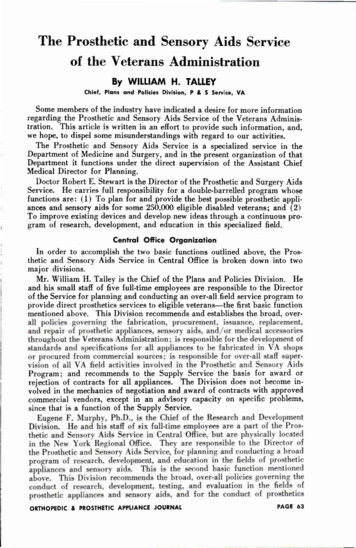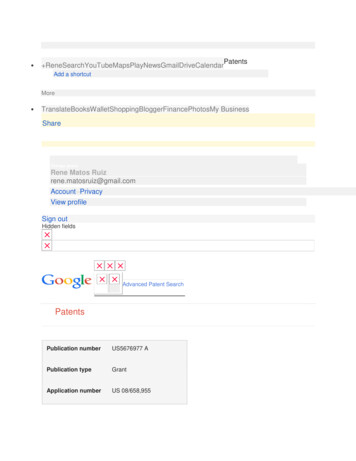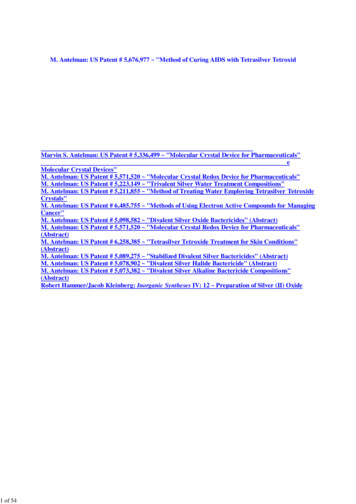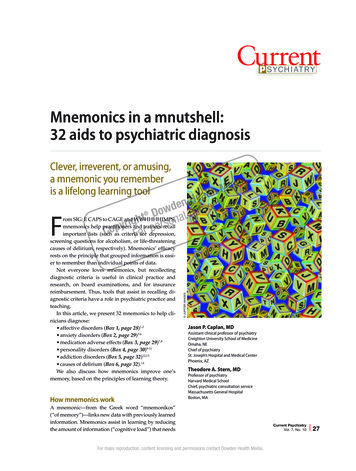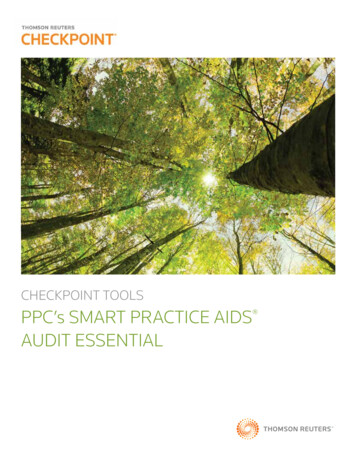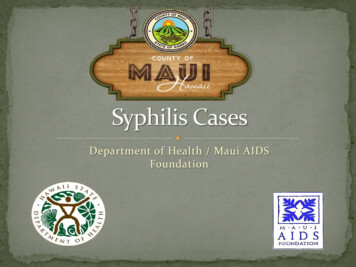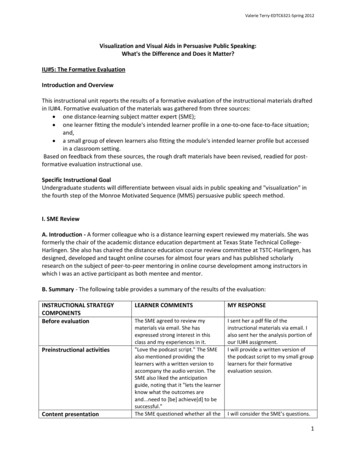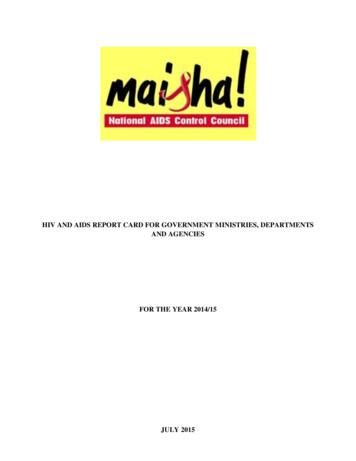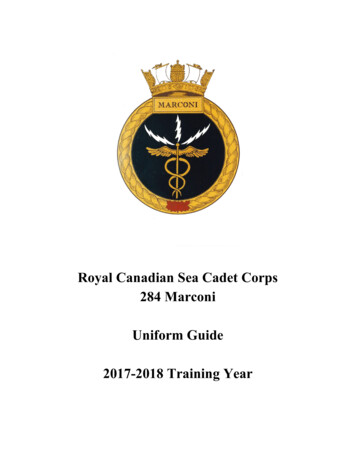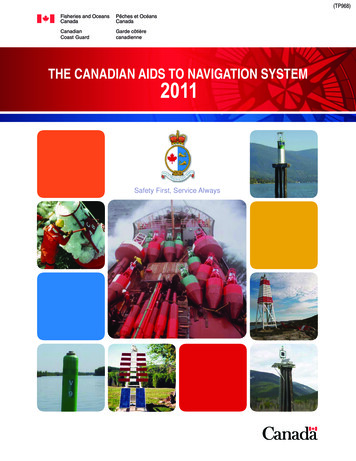
Transcription
(TP968)THE CANADIAN AIDS TO NAVIGATION SYSTEMSafety First, Service Always
(TP968)THE CANADIANAIDS TONAVIGATIONSYSTEMCanadian Coast GuardMaritime ServicesAids to Navigation Program
This publication can also be downloaded from:The Notices to Mariners website at: www.notmar.gc.ca under Available Services Section andthe Canadian Coast Guard website at: www.ccg-gcc.gc.ca/eng/Ccg/atn PublicationsFor all other related inquiries, please contact: atn-aln@dfo-mpo.gc.caPublished by:Aids to Navigation ProgramCanadian Coast GuardFisheries and Oceans CanadaOttawa, OntarioCanadaK1A 0E6Également disponible en français.Cat. No. T31-29/2012E-PDFISBN 978-1-100-15842-6MPO/2012-1704 Her Majesty the Queen in Right of Canada 2012.
TABLE OF CONTENTSCANADIAN COAST GUARD – TABLE OF he Canadian Aids to Navigation System.3Cautions in the Use of Aids to Navigation.6Related Legislation.10Canada Shipping Act, 2001.10Charts and Nautical Publications Regulation, 1995.10Collision Regulations.11Private Buoy Regulations.12Vessel Operation Restriction Regulations.13Criminal Code of Canada.14Canadian Coast Guard Aids to Navigation.15Other Government Aids to Navigation.16Private Aids to Navigation.17General.17Markings and Dimensions.18Public Notification.19Canadian Light Flash Characters.20IALA Maritime Buoyage System (Regions A and B).22Floating Aids to Navigation (Buoys).23Lateral Buoys.24Isolated Danger Buoys.26Cardinal Buoys.26Special Buoys.27Daytime Identification.30Nighttime Identification.32Other Characteristics.35V
CANADIAN COAST GUARD – THE CANADIAN AIDS TO NAVIGATION SYSTEMFixed Aids to Navigation.37General.37Lighted Fixed Aids.37Daybeacons.39Ranges.40Aural Aids.41Sector Lights.42Radio Aids to Navigation.43Radar Reflectors and Radar Beacons (RACONS).43Global Positioning System (GPS).44Differential Global Positioning System (DGPS).46Related Publications.48Canadian Coast Guard Aids to Navigation Offices.53Provincial Contacts – Office of Boating Safety.54United States Aids to Navigation Boating Information.55VI
PREFACEThe Canadian Coast Guard is pleasedto release the 2011 edition of theCanadian Aids to Navigation Systembooklet. This edition replaces the 2001 editionas the new standard for aids to navigationin Canada.As you will notice, there have been severalimprovements made to this edition. Thesechanges include updates to: Related Legislation Section with information on the Canada Shipping Act, 2001. 1Related Publications Section with a briefdescription of each publication includingweb addresses and links.Provincial contacts for the Canadian CoastGuard offices, Transport Canada Officesof Boating Safety and United States Aidsto Navigation Boating information.The Canadian Coast Guard is confidentthat the changes made in this version providethe most comprehensive view possible of theCanadian aids to navigation system.Long-range radio and satellitenavigation technologies.Web page addresses and links to differentMaritimes related information for mariners.CANADIAN COAST GUARD – PREFACE1
2NOTICES1.CANADIAN COAST GUARD – THE CANADIAN AIDS TO NAVIGATION SYSTEM2.2Mariners are requested to immediatelyreport any damage or failure of amarine aid to navigation to thenearest Canadian Coast GuardMarine Communications and TrafficServices Centre (Canada Shipping Act2001, par. 129(1), (2)) on VHF Ch. 16. orto a Canadian Coast Guard office by phone(see Canadian Coast Guard Aids to Navigation offices contact information section onpage 53 of this manual).3.It is not necessary to obtain TransportCanada’s permission to place or operatea private aid to navigation; however,all who propose to do so must ensurethat such aids conform to the PrivateBuoy Regulations and Navigable WatersProtection Act. Private buoy owners andoperators must also comply with VesselOperation Restriction Regulations.4.On August 3rd, 2010 the Canadian CoastGuard and United States Coast Guardjointly terminated the Loran-C servicecovering the East and West coasts ofCanada. Mariners are advised that theLoran-C service is no longer available andtherefore cannot be used for navigation.5.Canadian Coast Guard’s publicationsof the monthly Notices to Mariners(NOTMAR) are now only availableonline on the NOTMAR website at:www.notmar.gc.ca. (see related publicationsfor more details)The administration and enforcement ofthe Private Buoy Regulations, NavigableWaters Protection Act and Vessel OperationRestriction Regulation are under the jurisdiction of Transport Canada.Therefore, it is to be understood that allreferences to the above noted legislationsand/or regulations contained in this publi cation are now under the responsibility ofTransport Canada and all enquiries concerning these acts and regulations must bedirected to questions@tc.gc.ca.
INTRODUCTIONGENERALDefinitionAids to Navigation are devices or systems, external to a vessel, which are provided to assistmariners in determining position and course,to warn of dangers or obstructions or to adviseof the location of the best or preferred route.ResponsibilityThe Canadian Coast Guard is mandated,though not obligated, to provide aids to navigation in Canadian waters with the exceptionof waterways such as the Trent Severn andRideau waterways, which are served by ParksCanada. The Canadian Coast Guard shouldprovide, as deemed practical and necessary,such aids to navigation as justified by existingpolicies and directives.To facilitate the proper understanding andinterpretation of their function, aids to navigation are to be used in conjunction with othermarine publications. In particular, nauticalcharts, List of Lights, Buoys and Fog Signals,Radio Aids to Marine Navigation, SailingDirections, the Canadian Aids to Naviga-tion System, GPS/DGPS publications and theOwner’s Guide to Private Buoys. Informationconcerning nautical charts and Sailing Directionsmay be obtained from the Canadian Hydrographic Service, Department of Fisheries andOceans, Ottawa at www.charts.gc.caTHE CANADIAN AIDS TONAVIGATION SYSTEMThe Canadian Aids to Navigation System iscomprised of a mix of visual (lateral and cardinal), aural and electronic aids to navigation.Visual aidsVisual aids are short range aids to navigationincluding buoys, daybeacons, daymarks andlights. In Canada, a combined Lateral-Cardinalsystem of visual aids is used. Knowledge of thecharacteristics of each of these basic types of aidsis a prerequisite to the safe use of the system.Lateral aidsThe lateral system of buoyage in use inCanadian waters is IALA System B (seeIALA Maritime Buoyage System on page 22of this manual). Lateral aids may be in theform of either buoys or fixed aids. These aidsCANADIAN COAST GUARD – INTRODUCTIONOther Publications33
indicate the location of hazards and the safestor deepest water by indicating the side onwhich they are to be passed.The correct interpretation of lateral aidsrequires knowledge of the direction of buoyage known as the “upstream direction”. Theupstream direction is the direction taken by avessel when proceeding from seaward, towardthe headwaters of a river, into a harbour orwith the flood tide.When a vessel is proceeding in the upstreamdirection, starboard hand aids must be keptto starboard (right) and port hand aids mustbe kept to port (left).CANADIAN COAST GUARD – THE CANADIAN AIDS TO NAVIGATION SYSTEMCardinal aids4Cardinal aids may be in the form of eitherbuoys or fixed aids. However, their predominant use is in the form of buoys in the Canadiansystem.Cardinal aids indicate the location of hazardsand the safest or deepest water by reference tothe cardinal points of the compass. There arefour cardinal marks, North, East, South andWest which are positioned so that the safestor deepest water is to be found to the namedside of the mark (e.g. to the north of a northcardinal mark).Aural aidsAural aids are sound producing devices whichserve to warn the mariner of a danger underlow visibility conditions. Such aids includebuoy mounted bells and whistles which areactivated by wave action and fog signals onshore. Most aural aids are operated when visibility is reduced to less than two nautical miles.Electronic aidsThe electronic aids used in the Canadiansystem include radar reflectors, radar beacons (RACONs), and Differential GlobalPositioning System (DGPS). The advent ofe-Navigation and its many possibilities isbeing monitored for potential impacts and opportunities, such as the introduction of virtualaids to navigation, along with the AutomaticIdentification System, to better meet thechanging needs of our clients.Radar reflectors are passive devices which areused to strengthen the radar image of aids tonavigation whereas RACONs are active devices which, by means of a coded radar image,provide precise identification of the locationthey are marking.
DGPS is a method of improving the accuracyof the position derived from GPS receivers bycorrecting the inherent inaccuracies of theGPS signal and comparing it to a known geographic position.Note: A detailed listing of all lighted visualaids and all fog signals is contained inthe publication List of Lights, Buoys andFog Signals.A detailed listing of all electronic aidsis contained in the publication RadioAids to Marine Navigation.Winter NavigationWinter ice conditions may necessitate theremoval of buoys and the closing of the navigation season. The operation of aids to navigation on shore may also be discontinued duringsuch times. Some lights may be replaced bylights of lower intensity.Night NavigationMost buoys and many fixed aids are equippedwith retroreflective material. This retroreflective material is coloured to signify the
system of visual aids is used. Knowledge of the characteristics of each of these basic types of aids is a prerequisite to the safe use of the system. Lateral aids The lateral system of buoyage in use in Canadian waters is IALA System B (see IALA Maritime Buoyage System on page 22
